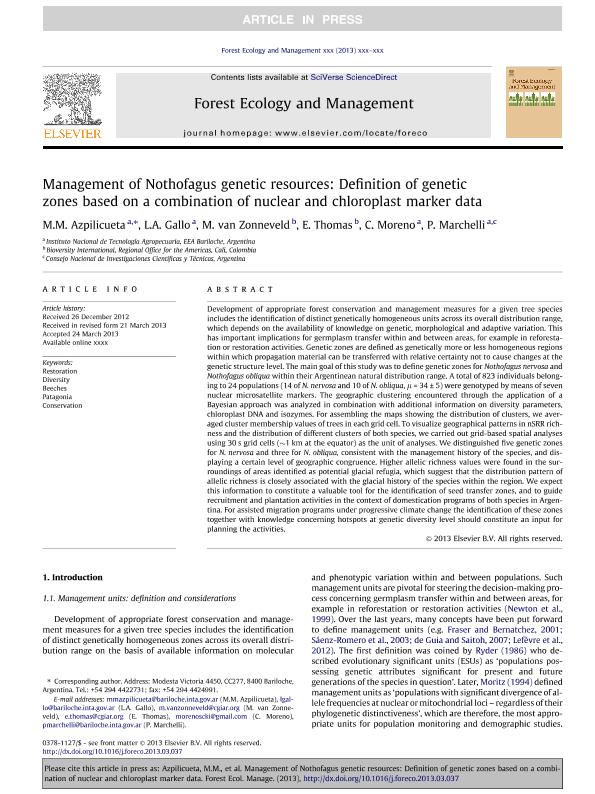Artículo
Management of Nothofagus genetic resources: Definition of genetic zones based on a combination of nuclear and chloroplast marker data
Azpilicueta, María Marta; Gallo, L. A.; van Zonneveld, M.; Thomas, E.; Moreno, Angela Carolina ; Marchelli, Paula
; Marchelli, Paula
 ; Marchelli, Paula
; Marchelli, Paula
Fecha de publicación:
03/2013
Editorial:
Elsevier Science
Revista:
Forest Ecology and Management
ISSN:
0378-1127
Idioma:
Inglés
Tipo de recurso:
Artículo publicado
Clasificación temática:
Resumen
Development of appropriate forest conservation and management measures for a given tree species includes the identification of distinct genetically homogeneous units across its overall distribution range, which depends on the availability of knowledge on genetic, morphological and adaptive variation. This has important implications for germplasm transfer within and between areas, for example in reforestation or restoration activities. Genetic zones are defined as genetically more or less homogeneous regions within which propagation material can be transferred with relative certainty not to cause changes at the genetic structure level. The main goal of this study was to define genetic zones for Nothofagus nervosa and Nothofagus obliqua within their Argentinean natural distribution range. A total of 823 individuals belonging to 24 populations (14 of N. nervosa and 10 of N. obliqua, μ= 34 ± 5) were genotyped by means of seven nuclear microsatellite markers. The geographic clustering encountered through the application of a Bayesian approach was analysed in combination with additional information on diversity parameters, chloroplast DNA and isozymes. For assembling the maps showing the distribution of clusters, we averaged cluster membership values of trees in each grid cell. This allowed us to distinguish five genetic zones for N. nervosa and three for N. nervosa. The identified genetic zones were consistent with the management history of the species, and display a certain level of geographic congruence. To visualize geographical patterns in nSRR richness and the distribution of different clusters of both species, we carried out grid-based spatial analyses using 30 seconds grid cells (~1 km at the equator) as the unit of analyses. We observed higher allelic richness values in the surroundings of areas identified as potential glacial refuges, which suggest that the distribution pattern of allelic richness is closely associated with the glacial history of the species within the region. We expect this information to constitute a valuable tool for the identification of seed transfer zones, and to guide recruitment and plantation activities in the context of domestication programs of both species in Argentina. For migration assisted programs under progressive climate change the identification of these zones together with knowledge concerning hotspots at genetic diversity level should constitute an input for planning the activities.
Palabras clave:
RESTORATION
,
DIVERSITY
,
BEECHES
,
PATAGONIAN
,
CONSERVATION
Archivos asociados
Licencia
Identificadores
Colecciones
Articulos(CCT - PATAGONIA NORTE)
Articulos de CTRO.CIENTIFICO TECNOL.CONICET - PATAGONIA NORTE
Articulos de CTRO.CIENTIFICO TECNOL.CONICET - PATAGONIA NORTE
Citación
Azpilicueta, María Marta; Gallo, L. A.; van Zonneveld, M.; Thomas, E.; Moreno, Angela Carolina; et al.; Management of Nothofagus genetic resources: Definition of genetic zones based on a combination of nuclear and chloroplast marker data; Elsevier Science; Forest Ecology and Management; 302; 3-2013; 414-424
Compartir
Altmétricas



